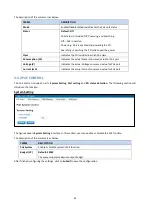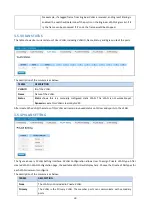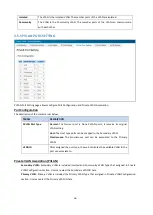
53
MSTP Port Setting
This page allows configure the Port settings. Choose the Instance ID user wants to configure. The MSTP enabled and
linked up ports within the instance will be listed in this table. Note that the ports not belonged to the Instance, or
the ports not MSTP activated will not display. The meaning of the Path Cost, Priority, Link Type and Edge Port is the
same as the definition of RSTP.
The description of the columns is as below:
TERMS
DESCRIPTION
Path Cost
Enter a number between 1 and 200,000,000. This value represents the cost of the path to
the other bridge from the transmitting bridge at the specified port. Path cost value is
derived from the media speed of an interface. If a loop occurs, the MSTP uses cost when
selecting an interface to put in the forwarding state. Lower cost values can be assigned to
interfaces that selected first and higher cost values that selected last. If all interfaces
have the same cost value, the MSTP puts the interface with the lowest interface number
in the forwarding state and blocks the other interfaces.
Port Priority
Enter a value between 0 and 240. This is the value that decides which port should be
blocked by priority in a LAN.
Link Type
There are 3 types for user selects
Auto, P2P
and
Share.
Some of the rapid state
transitions that are possible within RSTP depend upon whether the port of concern can
only be connected to another bridge (i.e. it is served by a point-to-point LAN segment), or
if it can be connected to two or more bridges (i.e. it is served by a shared-medium LAN
segment). This function allows link status of the link to be manipulated administratively.
Auto
- means to auto select P2P or Share mode.
P2P -
means P2P is enabled; the 2 ends work in full duplex mode.
Share -
means P2P is disabled; the 2 ends may connect through a share media and work
in half duplex mode.
















































